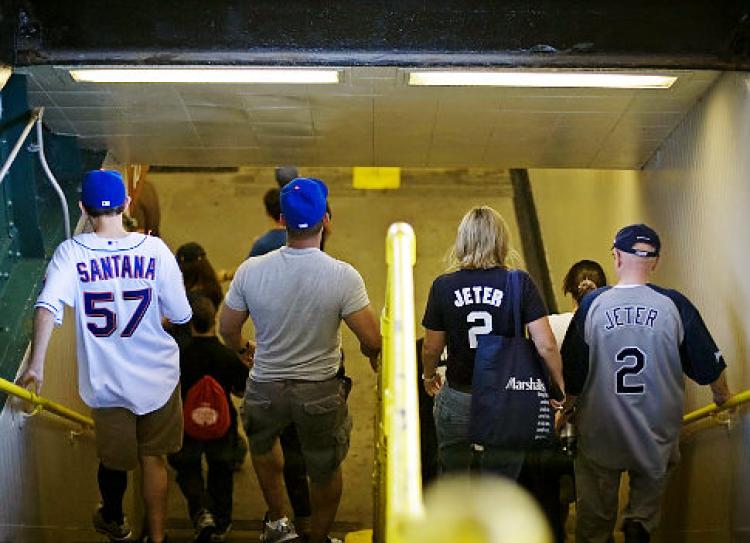|
Here is yet another poll I don’t want to hear. According to the highly-respected Quinnipiac Poll, residents of New York City prefer the Mets to the Yankees by 45-43 percent.
I’m a Met fan, totally out of the closet since retirement as a thoroughly impartial, you-never-could-tell sports columnist. I come by my National League/Long Island bias honestly as a boyhood Brooklyn Dodger fan who suffered terribly at the hands of the Yankees (to say nothing of, periodically, the New York Giants.) Quinnipiac is undoubtedly more correct when it says residents of New York State favor the Yankees by 48-34 percent. Those are the kind of odds I would have expected, what with all those World Series plus icons from Ruth and Gehrig to Jeter and Rivera. I have come to assume a lot of perfectly nice people have been swayed by the echoes in the “Big Ball Park in the Bronx” (Red Barber’s alliteration, not Mel Allen’s) and all those championships. Mets fans see their team as an occasional delightful surprise -- that World Series every decade or so, plus gallant efforts foiled by the 1987 Pendleton home run and the 1988 Scioscia home run and the 2006 Molina home run and the 2016 Inciarte catch – plus, the 2000 World Series when rich Yankee fans bought up huge swaths of Shea Stadium tickets. The gloomy words of George Orwell, personified. Now some New Yorkers may be swayed by all those fine young arms and the power of Céspedes and the dash of the prodigal son Reyes and the professionalism of Cabrera. Mets fans have expectations? Dangerous. I still want the Mets to be a minority taste which makes the Swoboda catch and the Mookie grounder all the more special. Then there is this: I don’t want my life guided by polls. Not anymore. Last autumn I was reassured by within-the-margin-of-error polls: the rational would squeak past the raging id. No more polls. * * * Play ball. Which the Yankees did, indoors, at Tampa Bay, on Sunday. By the second inning, I was immediately delighted with the fine details of baseball: -- Rays' LF Mallex Smith took a circular route but caught a fly in foul territory. -- Then, Smith (new to that team) took a piece of paper out of his pocket to scan the defensive scouting on the Yankees. Don't know that I've ever seen that. -- Between innings, the immortal voice of Bob Sheppard urged us -- stylishly, of course -- to follow the Yankees on the YES network. Nice touch. -- As starter Masahiro Tanaka faltered, he was watched intensely by three people in the Yankee dugout -- manager Joe Girardi, pitching coach Larry Rothschild and trainer Steve Donohue. Their faces told me: the real season has begun.
Altenir Silva
4/2/2017 07:29:54 pm
Dear George,
George Vecsey
4/3/2017 07:51:28 am
Dear Altenir: You know more from Rio about the Yankees than I do from Long Island.
Altenir Silva
4/3/2017 09:39:26 am
Dear George,
George Vecsey
4/3/2017 10:11:08 am
That is the classic. Gary Cooper didn't look like a powerful slugger...but he was the perfect strong silent type to portray Gehrig. My friend Ray Robinson wrote the biography about Gehrig and interviewed Teresa Wright, who played Mrs. G. She became friendly with Ray and his wife.
Altenir Silva
4/3/2017 11:04:37 am
Very cool. In this same year (1942), Mrs. Wright made "Mrs. Miniver", directed by William Wyler. One of the first movies to show what was happening in the war in Europe. I think Mrs. Wright and Mr. Cooper did a great job on the The Pride of the Yankees. 4/3/2017 06:32:19 pm
Alterir--Citizens of London: The Americans Who Stood with Britain in Its Darkest by Lynne Olson Is a fantastic book about wartime London.
Altenir Silva
4/3/2017 06:45:01 pm
Dear Alan,
Hansen Alexander
4/4/2017 02:07:34 pm
George,
George Vecsey
4/4/2017 10:44:26 pm
Hansen. good point. Mets hard to get some places upstate. My kid brother who teaches at Colgate is talking about driving back from Syracuse Wed evening, and will he be able to keep the digital radio on some Mets channel? Yankees are big. Where did you grow up in Adirondaks? It is a more national game now. I once heard Harry Reid talk about Game of the Week on TV in Searchlight, NV, and that's how he grew up to be a Jackie Robinson fan. Even in NYC you were not obligated. Joe Torre of Brooklyn was a Giants fan. My pal Vic Ziegel grew up near Grand Concourse (Bronx) and was a Giants fan. (Taught his freaking parrot to say, "The Giants win the pennant!") And of course, Yankees' recent morass would create a bulge of new Met fans. I'm still waiting for Newk and Preacher to come back. GV
Hansen Alexander
4/8/2017 02:44:50 pm
George, I was reared on a goat farm in small rural hamlet called Quaker Springs, between the old mill towns of Schuylerville and Stillwater on the Hudson River, and some 10 miles from Saratoga, where we sold hay to the racetrack in the summer. As I alluded to, Dodgers and Giants were still big, but Red Sox right up there with the Yankees, perhaps because the Sox Double A team was not too far away in Pittsfield, Mass, and we could get Red Sox games very clearly on WEEI radio out of Boston. In fact, because of the odd hills and valleys in the foothills of the Adirondacks, it was easier to get KDK? Pittsburgh with Bob Prince, Pirates, and WHAS, Louisville, with Harry Carry doing the Cardinals. Comments are closed.
|
Categories
All
|










